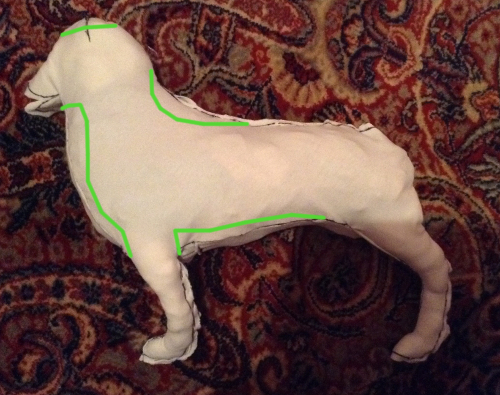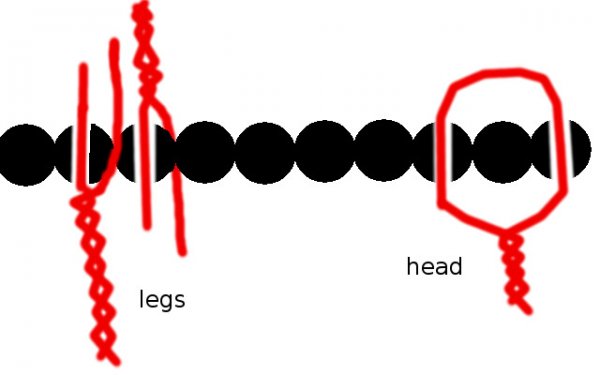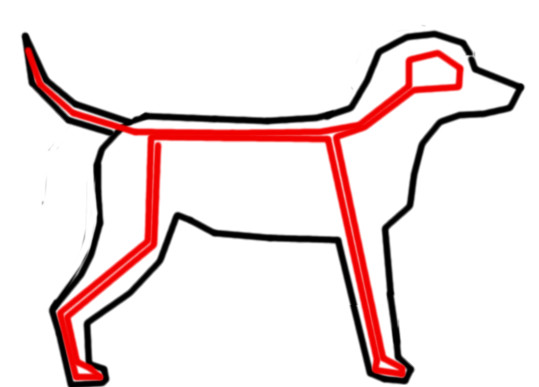For artists and collectors sponsored by Intercal...your mohair supplier and Johnna's Mohair Store
You'll have to sew the plush around the lockline anyway (with fur it would be impossible to turn), so you don't need a pattern.
Even without any stuffing the tip will be too thick to look realistic, but fortunately you won't see that under the fur. 
Yes, now it looks more like a pom to me. 
I would have made the head and neck in a lower, more stretched forward position. But that's up to you, every artist has to find their own way to work. 
I'm not sure if it's because of the stretchy fabric, but for me it doesn't look like a pom - or at least not a pom without fur, the neck and breast are too muscular. I always thought them to be very slim dogs under the fur, like a chihuahua?
More like this:
I think I would leave the muzzle as it is. It will look smaller since the head and body will get bigger with long fur.
If it' still too big in the end, it's no problem to make it smaller.
You could have split the big pattern parts to get them all onto the fabric piece...  Is your test dog finished already? So you are happy with the pattern?
Is your test dog finished already? So you are happy with the pattern?
I mostly use very small scissors (nail scissors or small embroidery scissors) and never had problems with cutting into the fur. Just be carefull and practice on the sample first.
I've never seen a plush that did unravel after cutting.
SilverClaw, that Chi is sooo cute!  I love the picture of him lying down on the floor.
I love the picture of him lying down on the floor. 
I would have added fur to clay parts, but well, that's just me - I want everything to look and feel as realistic as possible... 
PlushPuppy, those silicone noses look very good, but they are way to big. 
You could try to make one yourself of polymer clay. If you want it to feel soft you could cast it in silicone. It's also possible to model a nose directly out of silicone, but that can be tricky (I tried it a few times but were not happy with the result).
when doing the dip dying, is it similar to dying other fabrics?
Sorry, I can't really help, I've only used other brands of dye. But I've made the experience that dyeing alpaca and mohair can be quite surprising, I never know what colour I will get (I used "ochre" recently and endet up with a foxy red...  ). Don't know whats the reason, I never had this problem with cotton fabric (I follow the instructions for wool to dye alpaca).
). Don't know whats the reason, I never had this problem with cotton fabric (I follow the instructions for wool to dye alpaca).
i'm much more comfortable with cotterpin joints, i like the swing they have, but i was wondering if they could be used for adding an armature to. I will be using the plastic "loc-line" stuff.
Of course it works!  I've only made a few jointed animals, but all of them have armatured limbs.
I've only made a few jointed animals, but all of them have armatured limbs.
I really dislike lockline in legs, for me it feels just unnatural... But give it a try, maybe you like it. 
Check out Joanne Livingstons blogpost about it, it works the same way with cotterpins:
http://desertmountainbear.blogspot.co.a … again.html
Lovely face!  I was impressed how small this cutie is.
I was impressed how small this cutie is.
Can't see them... 
Maybe you could try to draw a picture of Fred? It's hard to imagine a bear with such a short description, without knowing what materials he was made of, the size, the head shape, where the seams are,...
You could also commission an artist to make a bear that looks like Fred.
But even if you can find another one like him... since every teddy has it's own personality you can never bring the real Fred back to your mother, so I'm not sure if she would be happy to have a copy? 
Glad I could help. 
The armature from probaer looks a little different than the one in your link, so they won't be compatible, but I guess both are similar in use.
In the head the loop is even more important. 
I would make the test dog first (or even a second or third test dog, if you want to alter the pattern) and built the skeleton to fit that dog, for me it's difficult to make a skeleton just from a pattern.
But if I understand your question correctly (damn English  )... If the legs of the pattern aren't completely straight (like on this dog), I would also bend the wire into shape for measuring.
)... If the legs of the pattern aren't completely straight (like on this dog), I would also bend the wire into shape for measuring.
Just an advice: don't put those cut ends in the paw, form a loop nearly as big as the sole of the foot to have poseable paws.
I buy my "doll armature" here http://www.probear.com/dollarmature and I use the 11mm as backbone (and the 6mm as tail).
It's normal that the fabric stretches a little bit in one direction, but if it is too stretchy you have to stabilize the backing.
It looks as if it could get matted easily, but it's hard to judge the quality just from pictures. Does the knit back stretch? Try clipping a part of the sample just to see if the fur is dense enough and looks fine at the base.
If it's okay - congratulation! 
I've worked with a lot of sythetics and always used normal sewing needles. The thread colour should match and I would recommend to use an extra strong thread, posing can strain the seams a lot.
Have you tried asking the manufacturer?
Looks sooo soft! 
Hi and welcome to TT!
Maybe this answers your question:
http://www.teddy-talk.com/viewtopic.php?id=29571
Good luck! 
I hope it works out for you, I'm looking forward to your report! 
The eyes and mouth are fantasic, very lifelike with a wonderful expression! 
I've read of artists using several coats of mod podge and sanding in between to get the nose smooth. But maybe simple acrylic shellack (don't has to be specific for wood), nail polish or wood glue would work too...
Why not give it a try (on a test piece of course  ) and tell us about the result?
) and tell us about the result? 
Get well soon, PlushPuppy. :rose:
Birgitte, I've still so much to learn, can't compete with really talented artists. 
It's always complicated to get the wire legs on the lockline spine.  I drill holes through the lockline and put one of the leg wires through it (a leg consists of 2-4 twisted wires).
I drill holes through the lockline and put one of the leg wires through it (a leg consists of 2-4 twisted wires).
Then I twist the wire ends around each other and around the opposite leg, I try to get it solid but not too bulky. For the head I just add a wire ring.
At the end I wrap the legs in tape and the whole armature in felt before putting it into the plush.
That's my way to do it, maybe other artists have found better solutions.
I mostly use insulated copper wire, the stuff you get in any hardware store, I think the plastic insulation makes it quite durable.
I make my armatures similar to a real skeleton with the spine directly under the back seam, like this:
So it's just a little bit smaller in heigh, just enough to wrap the spine in a layer of thick felt.
If you make a test dog out of cheap cotton fabric, you can make the armature to fit that dog.
The original print should be alright, you can enlarge or shrink the pattern as much as you want as long as the scale is the same size on all three parts of the pattern.
Hi Tony, I can't give an advise since I've never made a lace collar, but maybe it would help if you post the link to a picture of how the collar should look like. Do you want to chrochet it or make it of a piece of lace?